 |
|

|
 |
TABLE of CONTENTS
|
Hwy 210 in Jay Cooke State Park opens after five-year closure |
By Jennifer Swenson, Kimley-Horn and Associates, Inc.
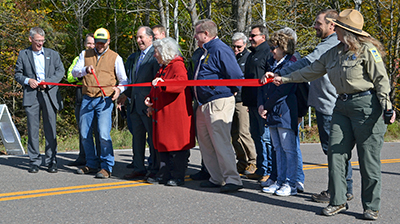
From left, District 1 Engineer Duane Hill; Aaron Gunderson, Hwy 210 project manager; and Commissioner Charlie Zelle joined local leaders for a ribbon-cutting ceremony to celebrate the re-opening of Hwy 210 through Jay Cooke State Park. Photo by Brian Miller, Kimley-Horn and Associates, Inc. |
MnDOT and the Department of Natural Resources hosted a ribbon-cutting ceremony to celebrate the re-opening of Hwy 210 through Jay Cooke State Park Oct. 4.
Hwy 210 runs through the park, following the St. Louis River. The highway is surrounded by steep slopes and deep valleys that have a long history of landslides caused by groundwater seepage and erosion. A major storm in June 2012 flooded the entire valley and caused extensive damage to the road and surrounding area. Landslides and road washouts occurred in more than 80 places along the highway, requiring the closure of three miles of Hwy 210.
Following the flood, MnDOT, working with the DNR and Minnesota Power, began the first round of emergency repairs. Emergency repairs were completed by October 2012 to restore access and basic operations to the park and provide access to Minnesota Power’s hydroelectric facility. The repairs included a new bridge by Oldenburg Point that was completed in fall 2013.

A storm caused washouts, landslides and inslope failures on Hwy 210 through the Jay Cooke State Park in 2012. Photo by Jim Sorenson |
As the owner of the highway, MnDOT needed to decide what to do after the emergency repairs were complete. To help guide future investment in this section of highway, an extensive two-year decision-making and public engagement process took place. Given the challenges of fully repairing this highway, consideration was given to closing Hwy 210 to through-traffic and converting it from a state highway to a low-maintenance park access road. After several public meetings and input from stakeholders, the decision was made to re-open the road as a through-route with continued ownership and maintenance by MnDOT.
Working closely with the DNR, MnDOT teamed with local design and construction firms to rebuild the highway and stabilize the surrounding slopes using cost-effective and innovative solutions, such as geo-web walls and anchor-reinforced vegetation. The team worked hard to locate and protect historic sites in the park and integrate the technical requirements of the project with natural-looking designs and native vegetation. MnDOT and the DNR worked to ensure that the roadway and slope repairs for this project incorporated stakeholder input and were designed with the park and its users in mind. The end result is an improved Hwy 210 that is safer for the traveling public, reduces the likelihood of future damage from flooding and erosion, and maintains the natural beauty of Jay Cooke State Park.
“I’ve had a lot of positive comments and interest from the public on the newly opened highway,” said Aaron Gunderson, Hwy 210 project manager and District 1 resident engineer. “On weekends, traffic has been nearly bumper-to-bumper. One person told me they visited the park four days in a row last week and learned that you need to get there by 9 a.m. or the parking lot will be full.”
Approximately 60 people attended the re-opening event. The celebration started with a media tour to highlight unique aspects of the project and provide photo opportunities. After the media tour, community members, project staff and local government officials gathered for a ribbon-cutting to officially re-open the road to the public. Cars and motorcycles were lined up waiting for the ribbon-cutting to take place so the public could once again enjoy the scenic drive through the park. The celebration ended with a news event at Oldenburg Shelter where Rep. Mike Sundin, Commissioner Charlie Zelle, District 1 Engineer Duane Hill and Jay Cooke State Park Manager Lisa Angelos spoke about the project and the successful partnerships that made it a success.
To learn more, watch the project video. |
 |
|

|
 |
TABLE of CONTENTS
 |
Maintenance crews prepare for winter |
By Sue Roe
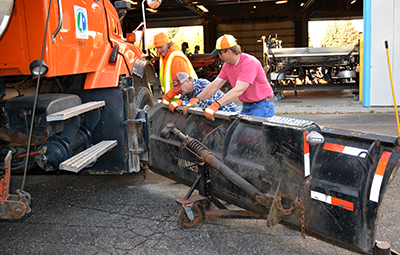
Joann Schuler, Dan Huycke and Henry Erickson move a wing plow into place to attach it to the truck Oct. 18 at the Lakeville Truck Station. Crews are rigging the trucks with snowplow equipment to get ready for winter. Photo by Sue Roe |
At MnDOT’s 159 truck stations, maintenance crews are shifting their focus to getting themselves and equipment ready to plow snow.
“We make sure we’re prepared for the worst of the winter weather,” said Dan Whebbe, District 3B supervisor from the Elk River Subarea truck station. “We’re reviewing what all our needs might be for snow and ice and will be rigging out our trucks in the next few weeks. There’s never a slow day in maintenance. We always have to be ready.”
MnDOT purchases 57 new trucks each year, placing the agency’s 843 trucks on a 14-year lifecycle that began in 2014. This plan allows for replacing older trucks, which are more prone to breaking down and provides an opportunity to incorporate newer technologies that are more efficient, safer and better for the environment.
Central Shop at Fort Snelling fabricates the new trucks by installing such items on the chassis as cab shield, underbody plow and sander. Shop employees also relocate the fuel tank and other components to accommodate the underbody plow. The trucks are then sent to a contracted vendor to install the hydraulic system, dump box and hoist. The trucks are returned to Central Shop for more installation including the lighting system, side wing plow, more hydraulics and operator controls. The trucks’ last stop is to the districts for customization, which may include installing radios, flags, cameras, front plow and hydraulics. See truck fabrication video.
“We like to get as many trucks out to the districts by Nov. 1 as we can, but it’s ongoing dependent on when the vendors deliver them,” said Bob Ellingsworth, Central Shop fleet manager.
At the Cook Truck Station, Greg Laine, subarea supervisor, said 90 percent of the trucks are ready.
“We’ve been working on the trucks the past two weeks,” he said. “The other 10 percent just need the sanders and plows put on and we can do that pretty quickly. It’s one of our busiest times of year between fall and getting ready for snow and ice.”
New snowplow drivers have either already attended or are attending Snowplow Operators Training, or SPOT. The first two-week session was in September and the second session is Oct. 16-27. More than 200 snowplow operators train during the two sessions. MnDOT has nearly 1,800 full-time and part-time drivers.
Each truck station has a winter kickoff meeting that includes discussing safety, regulations and plow routes. These kickoff meetings benefit new and veteran snowplow drivers.
Maintenance crews work in groups to outfit the trucks, something Rob Hendel, supervisor at the Lakeville truck station, said is good team building.
“We put three guys on each truck and they spend the day doing this. We have 12 trucks to put together with a crew of 19,” Hendel said.
The truck stations’ salt sheds have been full since early in the summer.
MnDOT has more than 202,625 tons of salt available for use this season, said Bob Vasek, maintenance operations engineer. That’s a few thousand tons more than the 197,417 tons used last winter.
“We order salt based on the past five years’ average with consideration of how much storage capacity we had in April when the quantities were established,” he said.
On the 511 traveler information system, the normal winter road conditions information was entered on the state map Monday, marking the official start of winter road reporting, according to Kelly Braunig, 511 program manager.
“All roads will be green on the map until we have conditions that require us to update them,” she said. |
 |
|

|
 |
TABLE of CONTENTS
 |
Traffic congestion in Twin Cities Metro area holds steady |
|
By Bobbie Dahlke, MnPASS and congestion management communications coordinator

Traffic on Twin Cities area highways increased by only .3 percent from 2015 to 2016. That is below MnDOTís 10-year projection for congestion increase. Photo by David Gonzalez |
Traffic on Twin Cities’ metropolitan area freeways held steady this past year, as congestion increased just .3 percent from 2015 to 2016 according to a MnDOT Metropolitan Freeway System Congestion Report.
The report, prepared annually by MnDOT’s Regional Transportation Management Center, shows roads are generally more congested between 5 a.m. and 10 a.m. than between 2 p.m. and 7 p.m.; however, the periods of congestion during the p.m. last longer. The slight increase is below MnDOT’s 10-year projection for congestion increase. Congestion is defined as freeway traffic flowing at speeds less than 45 mph and does not include delays that may occur at speeds greater than 45 mph.
“Construction, increasing population, a growing economy, gas prices, and the number vehicle miles traveled are all factors that affect congestion,” said Brian Kary, RTMC traffic operations director. “The department employs a number of strategies to alleviate congestion and provide a transportation system that allows residents, workers and visitors to move efficiently. Those strategies include MnPASS Express Lanes, additional roadway investments in key areas and the use of technology on ramp meters, signal coordination and transit advantage lanes.”
Projects addressing congestion include:
- A MnPASS Express Lane constructed on I-35E between Cayuga Street in St. Paul and County Road J in White Bear Lake, completed in 2016.
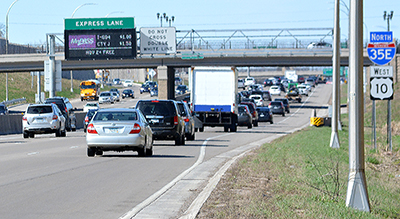
A MnPASS Express Lane was added to Interstate 35E in 2016 to help with highway congestion issues. Photo by Rich Kemp |
- Additional general purpose lanes on I-494 between Maple Grove and Plymouth completed in 2016 and on I-694 between Rice Street in and Lexington Avenue, complete fall 2017.
- The St. Croix Crossing on Hwy 36 between Oak Park Heights and St. Joseph, Wis., will carry between 30,000 and 40,000 vehicles each day. The new crossing will reduce congestion and boost economic development in the region. The St. Croix Crossing opened Aug. 2.
- Extended acceleration and deceleration lanes on Hwy 100 through St. Louis Park allowing motorists to safely access the highway and local roads, 2016.
- Preserved more than 337 miles of bus shoulders throughout the Twin Cities area, 2016-2017.
Future projects include:
- A new MnPASS lane on I-35W north between Hwy 36 in Roseville and Sunset Avenue in Lino Lakes beginning in 2018.
- A four-year project on I-35W Lake Street between 43rd Street and 15th Street in Minneapolis that includes adding MnPASS lanes, a transit station and additional access to the region, began late summer 2017.
- A bridge and pavement repair project that includes adding auxiliary lanes to I-494 in South St. Paul to Inver Grove Heights beginning in 2018.
In addition, MnDOT actively manages traffic through the use of technology:
- Ramp meters – operating only when needed, ramp meters are traffic signals on highway entrance ramps that manage the flow of traffic onto a highway. Ramp meters are designed and proven to reduce crashes, reduce congestion and provide more reliable travel times.
- Freeway Incident Response Safety Team - the FIRST program helps minimize congestion and prevent secondary crashes by quickly removing stalled vehicles from the freeway, providing traffic control at crash scenes, and removing crash debris from the road. FIRST patrols 220 miles of freeways in the Twin Cities area.
- Coordinating signals and traffic lights on roads that provide access to major highways.
- Real-time travel information – motorists can call 511 or access www.511mn.org, 24 hours a day, seven days a week to get information about road conditions, traffic incidents, commercial vehicle restrictions and weather information.
- Regional Transportation Management Center - located in Roseville, the RTMC is where State Patrol, MnDOT Maintenance and MnDOT Freeway Operations work together to quickly detect, respond to and remove incidents off of the freeway.
MnDOT gathers congestion data through detectors located in the roads and through field observations. For the 2016 congestion report, the RTMC collected data from 3,500 detectors in the road (there are 5,500 surveillance detectors, which includes ramps) on Twin Cities’ freeways. The traffic information was collected in October 2016, a month that has the most typical traffic patterns. |
 |
|

|
 |
TABLE of CONTENTS
 |
WIG project reduces time, cost, requirements, while improving customer experiences |
By Sue Mulvihill, deputy commissioner and chief engineer

Greg Coughlin presents State Aidís team sub-WIG about streamlining the Cooperative Agreement process by using Customer Centered Culture principles at a WIG 2.0 coaches training held in Arden Hills. Photo by Judy Jacobs |
For the past year, Operations, Engineering Services and State Aid divisions have been collaborating to redesign the Locally Initiated Cooperative Agreement process to improve customer experiences and earn customer trust.
“For many years people, internally and externally, have been sharing their frustrations and experiences while working in partnership to develop and deliver Locally Initiated Cooperative Agreement projects,” said Mitch Rasmussen, assistant commissioner, State Aid Division and co-champion for the Improved Intentional Customer Engagement priority area. “WIG 2.0 goals of customer involvement, impact and experience and focus areas of internal and external customer engagement have been priorities for the WIG 2.0 project team formed to streamline the Cooperative Agreement process.”
A Locally Initiated Cooperative Agreement project begins when a city or county brings forward a project idea to MnDOT and the two agencies form a partnership around that project. WIG 2.0 and the five-year Strategic Operating Plan, along with the support of the Customer Centered Culture or C3 methodology, has allowed the team to develop multiple recommendations based on product improvement and customer desired outcomes.
“I don’t know where this project would be without the C3 methodology and tools,” said Greg Coughlin, State Aid projects engineer and project manager. “Customers are both internal and external to our agency, and, in order to define a customer, a product and a producer must first be identified.”
“For example, a geometric layout is a product. For Locally Initiated Cooperative Agreement projects the local agency is the producer of that geometric layout and MnDOT is the customer," said Coughlin. “When MnDOT reviews the layout and produces a layout review comment letter, that letter is now a product and the local agency is the customer.”
MnDOT can achieve a 75 percent reduction in processing time for Level 2 and 3 Locally Initiated Cooperative Agreement projects and reach a 68 percent reduction in time for Level 1 Cooperative agreements, he said.
The project team spent many months analyzing current products and processes. They conducted statewide focus group workshops with 200 state, county, city and consultant participants. They also collected historical program and project data which validated customer experiences. The team then developed 24 recommendations to create a new process based on what customers said they wanted. These recommendations include shortening schedules, eliminating rework and redundancies, moving decision authority closer to the customers and instilling a customer mindset deeper into the organization.
“We can implement many of these recommendations immediately,” said Peter Harff, District 7 project manager. “These recommendations will help MnDOT build great relationships with our local partners.”
Some of the ways in which the new process will reduce time, cost, requirements, improve customer experience and earn customers trust:
- Program consistency, equal partnerships and increased transparency
- Leadership will require everyone associated with this local program/projects to commit to time, cost and requirement reductions.
- Coordinated process and district/local autonomy
- Each district will provide a dedicated Cooperative Agreement engineer for management, oversight and full decision authority
- Timely process and fewer reviews
- MnDOT will eliminate 60 percent plan requirements and geometric layouts for Level 2 and 3 projects with approval delegated from Central Office to the local district engineer.
- Project flexibility and scalability
- All unnecessary supporting documentation for all Level 1 projects that are submitted to Central Office will be eliminated
- Defined program, process, roles and expectations
- MnDOT will implement statewide training on the program including eligibility, roles, responsibilities and customer experiences
- Program funding will be increased (after the previous steps are implemented)
- For FY 18 and 19, $4.2 million will be programmed each year to deliver new projects. For FY 20, districts will contribute 5 percent of their trunk highway program.
Link to full list of recommendations
The recommendations brought forward from this WIG 2.0 team are deeply rooted in customer engagement, involvement, impact and experiences. One of the goals for MnDOT is to shift the organizational mindset from a producer-centered culture in which outcomes satisfy the agency to a customer-centered culture in which outcomes satisfy MnDOT's internal and external customers.
“We can implement many of these recommendations into our state-let programs as well,” said Chris Roy, assistant division director, Engineering Services Division.
The Senior Leadership Team unanimously approved all recommendations at their Sept. 19 meeting and will begin implementation immediately. Additionally, the Resource Investment Council approved increased funding for the program during fiscal years 2018 and 2019. |
 |
|

|
|

|
 |
TABLE of CONTENTS
 |
Chief of Staff offices celebrate employees, accomplishments |
By Judy Jacobs
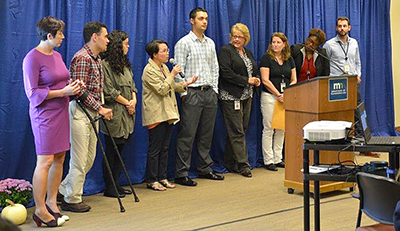
Members of the Commissionerís Staff Diversity and Inclusion Committee were honored during an event to thank employees of the Chief of Staff offices. From left: Sarah Rudolf, Civil Rights; Greg Ruhland, Communications; Jonica Carr, Civil Rights; Mayjoua Ly, Civil Rights; Rajan Nayar, Consultant Services; AnneMarie Burgess, WIG Team; Tammy Mansun, Office of the Chief of Staff; Verona Mitchell, Office of Equity and Diversity; and Adrien Carretero, Civil Rights. Photo by Adam Oie |
Employees from the Chief of Staff offices including Equity and Diversity, Public Engagement and Constituent Services, Government Affairs, Civil Rights, WIG 2.0, Chief Counsel, Audit and Communications, gathered Oct. 6 to “recognize, celebrate, hail and bid farewell” to their coworkers.
“It is my honor and privilege to invest a few minutes to say thank you for all of the hard work you do and often don’t get recognized,” said Eric Davis, chief of staff, who hosted the event.
Davis said the event was a direct result of the Listening Sessions that the Office of Equity and Diversity recently conducted.
“Feedback collected from these sessions noted that honoring and celebrating MnDOT employees, and the good work they do, is infrequent,” he said.
Davis also recognized each of the members of the Commissioner’s Staff Diversity and Inclusion Committee who inspired and organized this event.
“Thank you! You walk the walk,” Davis said.
Commissioner Charlie Zelle also addressed the group.
“We need to focus more on the ‘who’ than the ‘what,’” said Zelle. “This event is about what we have accomplished—singularly and collectively.”
Office directors presented highlights from their office—including awards, honors, new hires, retirements, service awards, promotions and shared success stories.
“The recognition event goes back to days past where we interacted with each other at picnics, bowling events, volleyball and dances,” said Dan Kahnke, Audit director. “Today, we can interact with each other via email and sometimes don't really know what the person we’re working with looks like. This event allowed us to put a face with an email.”
“Between attending meetings, meeting our deadlines and performing simple day-to-day tasks, we’re always on the go,” said Richard Davis, Public Engagement and Constituent Services director. “This event is a wonderful opportunity to press pause and take time to recognize our staff for their service to MnDOT and thank them for a job well done.”
Communications Director Kevin Gutknecht said, “The event was great. I enjoyed it and, more importantly, my team enjoyed it. We often forgo events like this because of time limitations, and we shouldn't. I am glad we made time for it."
Ned Rousmaniere, state employee assistance program director, Minnesota Management and Budget, talked about the importance of self-care and how to navigate stress with resilience.
“Change is constant and often causes stress like uncertainty, fear, anger and grief,” said Rousmaniere. “When a stressful situation presents itself, look at ways to accept it and work with it. Humor can really help keep things in perspective.”
For more information about worksite wellness, visit mn.gov/mmb/segip/health-solutions/worksites-shs/worksite-wellness.
“I really wanted to hold this event for Chief of Staff employees,” said Eric Davis. “Operations does this a lot through their Employee Days. I really encourage others to do this type of event. It had a wonderful and warm tone and really creates a stronger sense of community.” |
 |
|

|
|

|
 |
TABLE of CONTENTS
 |
MnDOT Library celebrates 60 years during open house |
By Karen Neinstadt, MnDOT Library
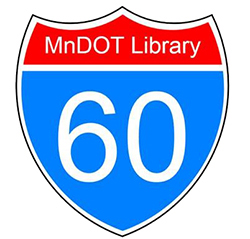
The MnDOT Library will celebrate 60 years during an open house Oct. 25. |
In celebration of its 60th Anniversary, MnDOT Library will be hosting an open house on Oct. 25, from 11 a.m. - 3 p.m.
The open house will take visitors back in time to a display that goes back to October 1957 when MnDOT Library first opened at 1246 University Ave. (near Griggs Street, a few blocks west of Lexington Avenue).
The purpose of the library was to preserve and catalog great amounts of technical literature gathered and used by highway engineers and technicians and to make this material available to others. The original library had just 300 titles and one librarian on staff.
This mission continues today, but the library has since added many more titles and formats-including electronic resources.
No formal program is planned, but people are encouraged to stop and chat with the staff and check out displays, browse the collection, enjoy light refreshments, participate in activities, and view 15-minute demos of library resources (1 p.m. and 2 p.m.).
For those who are unable to participate in person, tune in online to the 15-minute demos (1 p.m. and 2 p.m.) and a short quiz on 1957 history. Visit http://ihub/library/ on the day of the event to participate.
The library is located on the 1st floor of the Central Office. For more information, contact the library at 651-366-3791 or library.dot@state.mn.us |
 |
|

|
 |
TABLE of CONTENTS
 |
Perpetual Pavement Award presented to District 3 for stretch of Hwy 371 |

Hwy 371 in District 3 received the Perpetual Pavement Award that recognizes long-lasting and high-quality asphalt pavements. Photo by TJ Melcher |
MnDOT received a Perpetual Pavement Award from the Asphalt Pavement Alliance for a 7.7-mile section of Hwy 371 in Cass County, between Pine River and Backus. MnDOT has won 15 Perpetual Pavement Awards and it is the only state DOT to have received the award every year since 2002.
The award is presented to state transportation departments and local agency road owners for well-performing asphalt pavements that are at least 35 years old with proven high-quality structural design. To earn the award, the pavement must have not suffered a structural failure, and it should have an average interval between resurfacing of no less than 13 years.
“We are proud to receive our 15th Perpetual Pavement Award,” said Sue Mulvihill, deputy commissioner and chief engineer. “From the construction staff who installed the pavement many years ago, to the maintenance staff who have kept it performing for years, District 3 folks can be very proud of the work they have done on Hwy 371.”
The award-winning section of Hwy 371 is a two-lane road built in two stages. The original construction in 1971 consisted of 11 inches of granular material, one inch of stabilized aggregate, a 4.5-inch aggregate base, and a 1.5-inch asphalt surface course. MnDOT added another 2 inches of asphalt pavement mixture to the surface in 1977. The pavement has been resurfaced only once since that time. In 2014, MnDOT milled 2 inches from the pavement and overlaid it with 3.5 inches of asphalt pavement mixture. |
 |
|

|
 |
TABLE of CONTENTS
 |
WIG 2.0 through lens of MnDOTís Core Values |
By Tracy Hatch, deputy commissioner, chief operating officer and chief financial officer, and
Sue Mulvihill, deputy commissioner and chief engineer

Tracy Hatch is MnDOT's deputy commissioner, chief operating officer and chief financial officer. Photo by Rich Kemp |
WIG 2.0 teams across the state are working on over 500 sub-WIGS (with nearly 170 already completed) in the WIG 2.0 focus areas of workforce, contracting, internal customer engagement and external customer engagement. During the course of the next year, teams will develop plans to incorporate the accomplishments from their sub-WIGS and put that work into MnDOT’s daily whirlwind (for help with this, see the worksheet, “Putting Your Sub-WIG Back Into the Whirlwind”). As teams work towards advancing equity and improving intentional customer engagement it is helpful to keep MnDOT’s core values in the forefront of our minds for guidance on how we do our work.
As an agency, MnDOT intentionally selected Enhancing Financial Effectiveness for WIG 1.0 and Earning Customer Trust for WIG 2.0 so we have alignment between our strategic goals and our core values. WIG 2.0 helps MnDOT strengthen how we live our core values of:
- Safety – Safety addresses MnDOT employees’ and the public’s well-being on our transportation system. It pushes us to revisit, assess, re-engineer, train and hold one another accountable. We want all MnDOT employees to be safe at all times. Over 120 sub-WIGs mention “safety.” This tells us teams are using WIG 2.0 as an opportunity to address safety as it relates to Advancing Equity and Improving Intentional Customer Engagement.
- Excellence – We push ourselves to be the best and set high standards of professionalism and competence in all our work. One of the ways MnDOT strives for excellence is by working to achieve our Wildly Important Goals as an agency.
- Service – Service is a commitment to generously apply our experience, skill and knowledge to help improve the experience and quality of life of our coworkers, our customers and the world. This core value is strongly aligned with WIG 2.0’s desired outcome and our priority to Improve Intentional Customer Engagement.
-

Sue Mulvihill is MnDOT's deputy commissioner and chief engineer. Photo by David Gonzalez |
Integrity – We have an uncompromising commitment to honor, moral, ethical and spiritual values and can be counted on to behave honorably – even when no one is watching.
- Accountability – Accountability reflects our willingness to keep our commitments, to honestly assess our strengths and liabilities, and to acknowledge and learn from our mistakes and actions. Cadence of Accountability is a foundational component of 4 disciplines and WIG 2.0.
- Diversity and inclusion – We share a commitment to honor and value people with different perspectives, different cultures and different backgrounds. We are also mindful of involving and incorporating these diverse perspectives and experiences into our approach to transportation. This core value is strongly linked to our priority to Advance Equity.
Watch for more information coming soon on the strategic alignment between MnDOT’s mission, vision, family of plans, core values, strategic operating plan and WIG over the next several months.
If you have any questions or need help clearing the path on any challenging areas, please don’t hesitate to contact either of us, a WIG Champion, your local coach(es) or the WIG Team. We are committed to helping your teams succeed in your efforts.
Thank you for your great ideas, your amazing energy and your dedication to making MnDOT a great place to work. |
 |
|
| |
|



